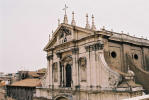|
|
 |
|
The Jesuits: Il Gesu and Sant'Ignazio as Triumphant Churches |
|
written
by hlc / 09.16.2004 |
|
|
|
The Church of Sant' Ignazio |
| |
Patron |
| |
| |

|
| www.benno-kuppler.de/ images/Benno_Kuppler_Rom... |
| Facade of Sant'Ignazio |
|
| |
|
| |

|
| www2.rz.hu-berlin.de/ requiem/galerie/S-Ignazi... |
| Cardinal Ludovico Ludovisi |
| Ludovisi was the main benefactor of Sant'Ignazio and this image is from his funerary monument in the church. |
| |
|
The church of Sant’Ignazio was built half a century later then Il Gesu, with construction beginning in 1626 and finishing in 1650. It was built as the church of the Collegio Romano, a Jesuit college, in order to honor St. Ignatius and his canonization. The Jesuits now had their own saints to honor, and this serves as propaganda for the faith. Sant’Ignazio is entirely baroque in style, and its grandeur represents the power, following, and money that the Jesuit Order had gained in a century.
Pope Gregory XV’s nephew, Cardinal Ludovico Ludovisi, was the major benefactor of Sant’Ignazio and emblazoned his name and family crest on the façade and throughout the church. A chapel inside Sant’Ignazio even houses an elaborate funerary monument to both Ludovisi and his uncle. The following quote of Ludovisi demonstrates how proud he was of his generous patronage to the church, “One raised St. Ignatius to the alter, while the other raised alters to Ignatius.”
|
| |
|
| |
|
| |
Church Layout / Interior Design |
| |
| |

|
| www.math-inf.uni-greifswald.de/ mathematik+kun... |
| The False Dome |
| This dome, painted by Pozzo, was done on a flat surface and demonstrates his mastery of illusion. |
| |
|
The interior of Sant’Ignazio is in the shape of a Latin cross (the length is equal to two times the width) with a wide nave and apse. Like Il Gesu, this emphasizes large open space, and creates an optimum environment for giving sermons. A large cupola was planned for the nave but the Jesuits ran out of money so it could not be completed. Instead, Andrea Pozzo painted a false dome – the ceiling is really flat. The optimum spots for viewing the false dome and nave ceiling painting are indicated by small yellow circles inlaid in the church floor. The illusion of perspective is most realistic at these two points. Theatricality is also prevalent in the grand and impressive Baroque decoration of this church.
|
| |
|
| |
|
| |
Triumph of Sant' Ignazio |
| |
| |

|
| www.chss.montclair.edu/ classics/HUMAN2RC3.HTML |
| "Triumph of Sant'Ignazio" fresco |
| Painted by Pozzo, this ceiling creates the illusion that heaven is opening up over the heads of the congregation. |
| |
|
Fr. Andrea Pozzo (1642-1709) designed the “Triumph of Sant’Ignazio” nave painting for this church. Pozzo, an ordained member of the Jesuit order, was famous for his mastery of perspective painting, and like Baciccio, had many religious art commissions. He won a competition to design and execute the nave painting of St. Ignatius, which took three years to complete (1691-1694). The dome, transept chapels, and apse are also decorated by Pozzo.
At the center of this expansive fresco Pozzo places Jesus with his cross. A ray of light travels from God, to the heart of Jesus, to St. Ignatius, who is carried on a cloud up to heaven. Ignatius acts like a mirror here, reflecting divine light out to the rest of the heavenly figures. Below Ignatius and to the right, is St. Francis Xavier, one of the original Jesuits, who is known for his missionary work in the Far East. The faithful followers of Jesus rise to the center of the fresco, while heretics are turned away and tumble downwards. In the four corners are women personifying the four continents of the known world: Europe with a horse, Asia with a camel, Africa with a crocodile, and America with a mountain lion. Jesuit missionary activity was occurring during this time in these areas.
The ceiling of Sant’Ignazio appears to soar to the heavens, which again, creates the feeling of truly being in the presence of heaven and the spiritual world. Pozzo strengthened this illusion of the nave by continuing the Church’s architecture into the painting which makes the roof extend even further upward. The four personified women depict the worldwide victory of the Catholic Church in missionary work. Both of these aspects serve as propaganda for the Church.
|
| |
|
| |
|
|
 |
|




